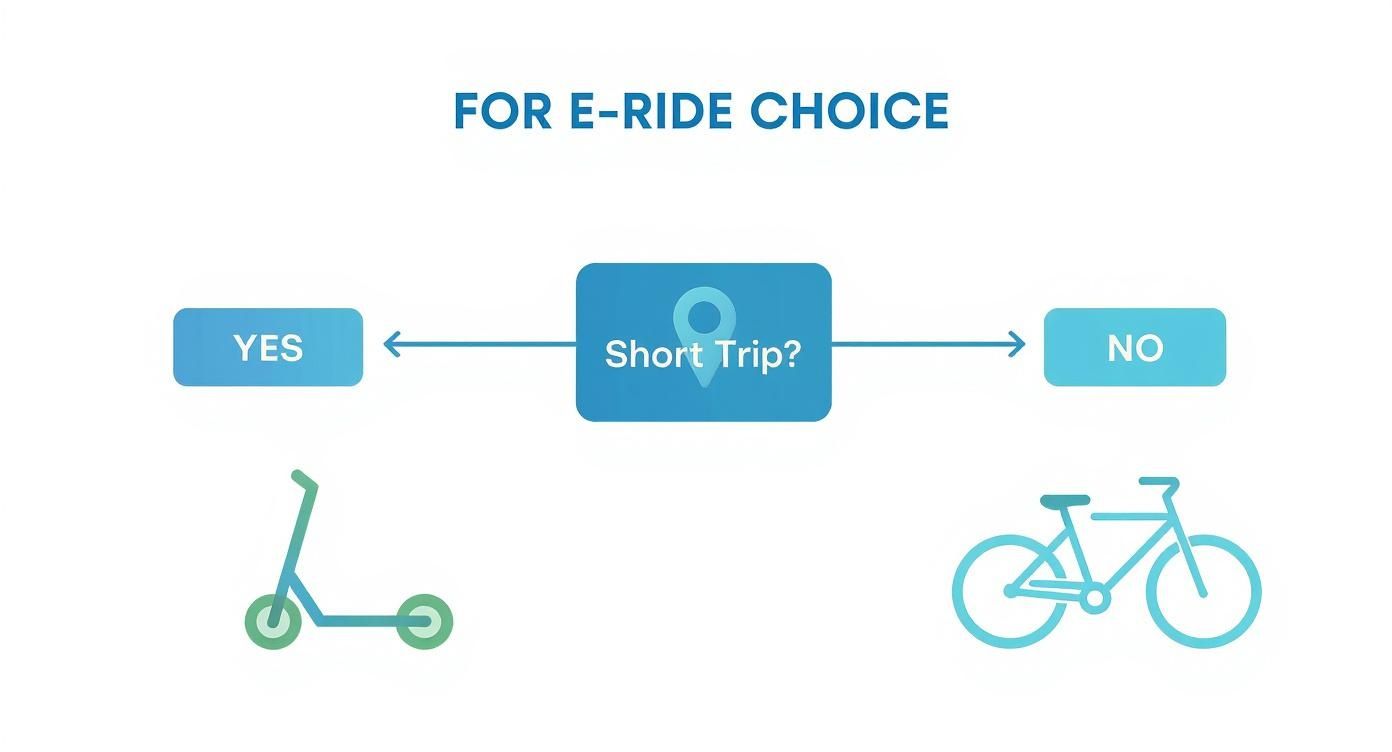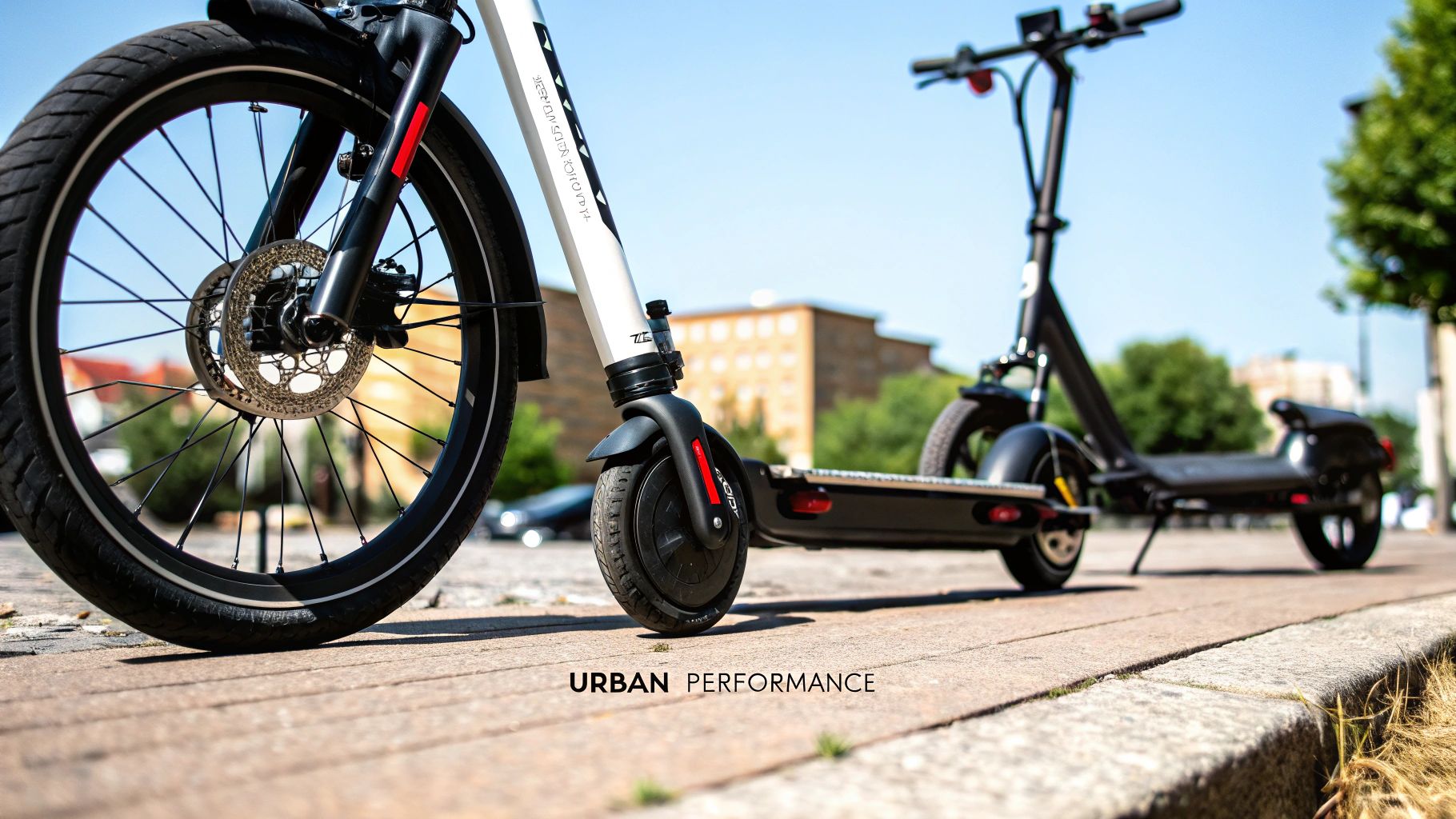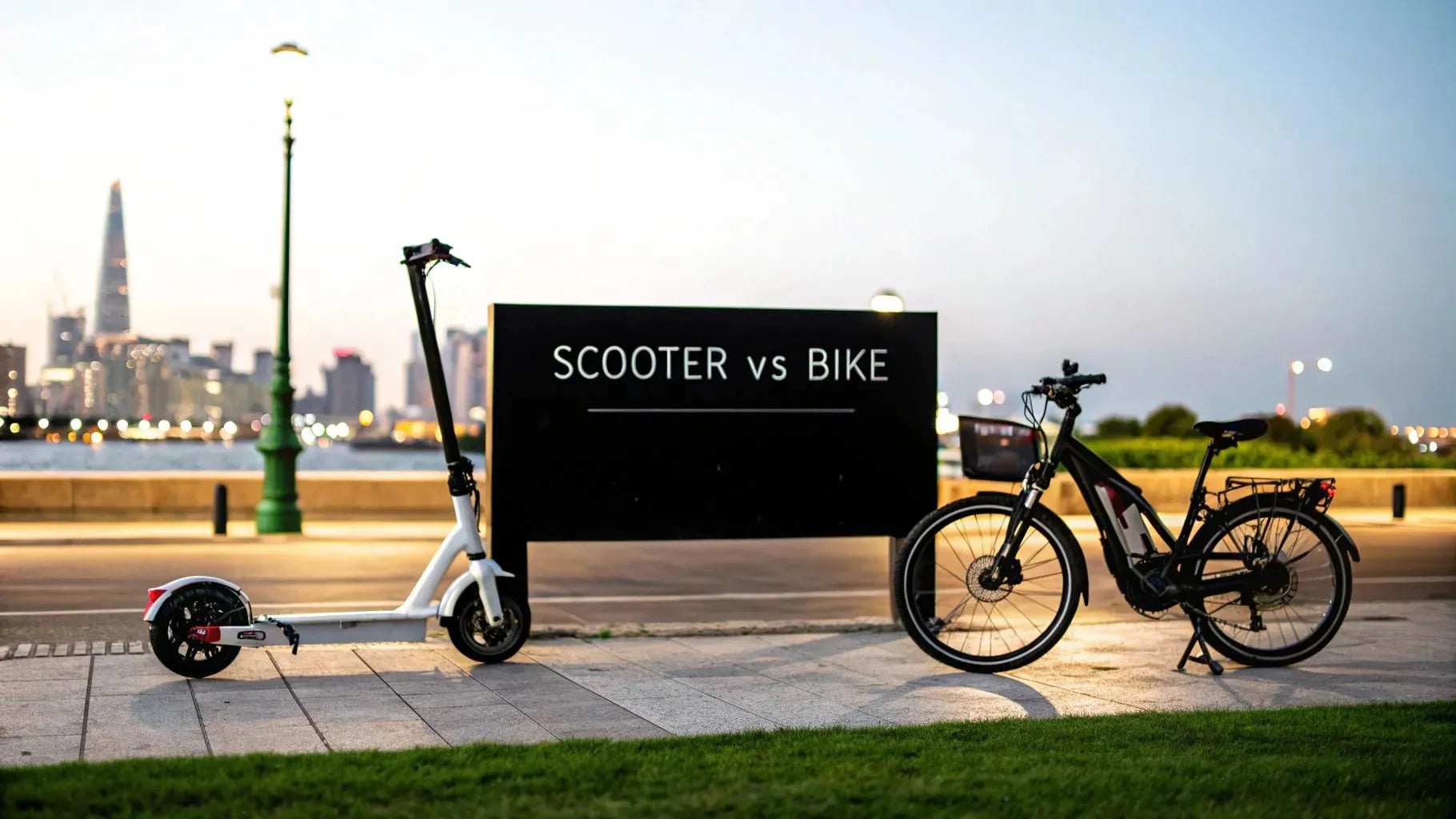When you get right down to it, the choice between an e-scooter and an e-bike is pretty simple. E-scooters are the ultimate tool for short, "last-mile" trips because they're so easy to carry around, while e-bikes have the comfort and range to handle longer commutes. It all depends on what you need: a quick, foldable ride for that final stretch, or a more serious machine that can replace your car or bus pass.
E-Scooter vs E-Bike: Which Is Right For You?
Trying to pick between an electric scooter and an electric bike can seem tricky, but it really boils down to your daily routine. Are you zipping through a packed city center for a mile or two, or is your commute longer and more varied? Figuring that out will point you straight to the perfect ride.
E-scooters are the undisputed kings of "micro-mobility." Their biggest selling point is how incredibly portable they are. Most are light enough to fold up and carry onto a train, tuck under your desk, or stash in a tiny apartment. They're perfect for closing that gap between the train station and your front door.
E-bikes, on the other hand, are becoming real car-replacements for many people, especially across the US and Australia. Their bigger wheels and solid frames give you a much safer, more stable ride over bumpy city streets and potholes. Plus, you can load them up with panniers for groceries or a gym bag, giving them a level of utility a scooter just can't match.
At a Glance: Key Differences Between E-Scooters and E-Bikes
To make this even clearer, let's lay out the most important distinctions side-by-side. Think of this table as a quick cheat sheet for weighing the pros and cons.
| Feature | E-Scooter | E-Bike |
|---|---|---|
| Primary Use Case | Short, "last-mile" trips (e.g., from train to office) | Longer commutes, errands, and fitness |
| Portability | Excellent; typically lightweight, foldable, and easy to carry | Limited; heavier and bulkier, requires proper storage |
| Comfort Level | Lower; standing position can be tiring on longer rides | High; seated position is comfortable for extended travel |
| Ride Stability | Lower; small wheels are vulnerable to road imperfections | High; large wheels handle bumps and potholes easily |
| Legal Status (US/AUS) | Varies by state; can be complex for private use | Generally simple; treated like standard bicycles |
| Cargo Capacity | Minimal; limited to what you can carry in a backpack | Excellent; can be fitted with racks, baskets, and panniers |
This handy infographic really helps you see the decision-making process based on what you need most.

As you can see, the whole e-scooter vs. e-bike debate often just comes down to your typical trip distance. Once you know that, the right choice for your commute becomes much more obvious.
Understanding The Micromobility Market Shift

Before you can pick a winner in the e-scooter vs. e-bike showdown, it helps to understand the bigger picture of where the market is going. Personal electric transport isn't just getting more popular; it's branching off in two very different directions based on how people actually use these things. This split gives you a ton of insight into long-term value, what kind of support you can expect, and which ride is genuinely right for you.
On one side of the ring, you've got the e-bike. It's gone from being a niche gadget for enthusiasts to a full-blown commuting machine. For tons of people navigating sprawling cities in the US and Australia, e-bikes are becoming a real-deal car replacement, not just a toy for the weekend. Their comfort, versatility, and ability to eat up longer distances are what's driving this trend.
This boom in people buying their own e-bikes has created a huge, mature market. We're talking a global market valued at around USD 61.89 billion that's projected to hit USD 113.64 billion by 2030. The kicker? Personal use accounts for over 86% of that, which tells you people overwhelmingly prefer to own their e-bike rather than rent one.
E-Bikes: The Rise Of Personal Ownership
The massive shift toward e-bike ownership shows a real change in how we think about getting around. An e-bike isn't just for a joyride; it’s a practical tool that gives you the health perks of cycling with the extra oomph of an electric motor. Suddenly, longer commutes, killer hills, or even a run to the grocery store become totally doable.
This strong ownership culture has some serious upsides for you as a buyer:
- Solid Aftermarket Support: With so many e-bikes out there, you'll find a massive selection of spare parts, cool accessories, and mechanics who know what they're doing.
- Better Resale Value: Because people see them as durable transportation, a well-cared-for e-bike holds its value much better than a scooter.
- Constant Innovation: The big brands are pouring money into better batteries, more efficient motors, and smarter frame designs to keep up with what daily riders need.
The whole world built around e-bikes is set up for the long term, much like the traditional bicycle industry. This makes buying an e-bike feel like a solid investment in your daily commute. You can get a deeper dive into this shift by checking out our guide on what is urban mobility.
E-Scooters: Kings Of The Last Mile
E-scooters, on the other hand, have carved out their own territory, and it looks a lot different. They absolutely dominate the shared, short-term rental scene. You've seen them everywhere—companies like Lime, Bird, and Spin have flooded city centers with their app-based scooters, changing the game for how people cover that final stretch of their journey.
The real magic of the e-scooter is its "grab-and-go" convenience. It's the perfect solution for the "last-mile problem"—that awkward gap between the train station and your office that’s a bit too far to walk but way too short for a cab.
This rental-first approach really shapes the market for personal e-scooters. The main focus is on being incredibly portable. We're talking lightweight, foldable designs you can easily carry on a bus or stash under your desk at work. While you can definitely buy your own e-scooter, the way the market is set up shows they're best for those quick, short hops, not as your main way of getting around. Getting this distinction is the key to not buying a ride that doesn't actually fit your daily routine.
Navigating The Patchwork of US and Australian Regulations
When you're trying to decide between an e-scooter and an e-bike, there's one topic that trumps everything else: the law. In both the United States and Australia, the legal status of these two rides can vary wildly from one state to the next, and this single factor can make or break your daily commute.
Getting this wrong isn't just about risking a fine; it's the difference between a reliable daily ride and an expensive paperweight gathering dust in your garage.
E-Bikes: The Generally Straightforward Choice
Let's start with the easier one. The situation for e-bikes is refreshingly simple in most places. The US uses a popular three-class system to define e-bikes, which many states have adopted. This framework generally treats e-bikes like regular bicycles, meaning you can ride them in bike lanes and on roads.
- Class 1: Pedal-assist only, with a top assisted speed of 20 mph.
- Class 2: Has a throttle and can be powered without pedaling, but still maxes out at 20 mph.
- Class 3: Pedal-assist only, but can reach a higher top assisted speed of 28 mph (often requires a helmet).
Australia has a similar national standard. As long as the motor is 250 watts or less and is pedal-assist only (no throttle), it's treated just like a normal bike. This clarity means you can generally buy an e-bike with confidence, knowing you can ride it almost anywhere a regular bike can go.
The E-Scooter Legal Maze
Now, for the complicated part. E-scooters in both the US and Australia are stuck in a legal patchwork. There's no single federal law, so rules about speed, where you can ride, and whether you need a license change dramatically when you cross state lines.
The bottom line for US and Australian riders is stark: you must check your local state and city ordinances before buying or riding a private e-scooter. What's perfectly legal in California or Brisbane might get you a hefty fine in New York or Sydney.
So what about those rental scooters you see zipping around cities? They operate under specific city-approved trial programs or permits. These schemes ensure the scooters are insured and meet safety standards, giving them a legal pass to operate in certain areas. Your private e-scooter, even if it's the exact same model, often doesn't get that same legal protection.
This creates a massive divide in the e-scooter vs. e-bike debate. An e-bike owner can confidently ride across town, while a private e-scooter owner must constantly be aware of the specific rules for their location.
A Quick Look at E-Bike Rules
For an e-bike to get that "just like a regular bike" legal status in most parts of the US and Australia, it has to meet a few technical rules. Knowing these is key.
- Motor Power: The US focuses more on speed classes, while Australia sticks to a 250-watt motor limit for its standard.
- Speed Assist: US e-bikes have assisted speed limits of 20 mph or 28 mph, depending on the class. Australia's standard cuts off assistance at 25 km/h (15.5 mph).
- Pedal-Assist vs. Throttle: The US system allows for throttle-powered (Class 2) e-bikes, while Australia's national standard is strictly pedal-assist.
As long as your ride fits within these local frameworks, you're golden. This legal clarity is a huge win for e-bikes. For a more detailed breakdown, check out our guide on whether electric bikes are street legal.
How Do State Regulations Compare?
The situation is a patchwork of different state and city laws. Some US states, like California, have very clear and permissive laws for e-scooters. Others are far more restrictive.
Similarly, in Australia:
- Queensland (Brisbane): Has fully embraced e-scooters, allowing private ownership with speed limits and defined riding areas.
- New South Wales (Sydney): Has some of the strictest rules, largely banning private e-scooters from public roads and paths.
- Victoria (Melbourne): Allows low-powered e-scooters with speed caps, but the rules can still be confusing.
The main takeaway here is that you absolutely must check the local laws for your specific state and city. The legal landscape for e-scooters is far more complex than the simpler, more consistent status that e-bikes enjoy across both countries.
Real-World Performance and Feature Showdown

Forget the spec sheets for a minute. The real test is navigating a pothole-ridden street during rush hour, and that’s where the differences between e-scooters and e-bikes really hit home. This is where the paper-to-pavement reality check happens.
The first thing you'll notice is the ride quality. An e-bike’s large wheels—often 26 inches or more—just glide over cracks, drain covers, and bumpy pavement. You get a sense of stability that’s crucial when you’re sharing the road with cars and buses.
Hop on an e-scooter, and it’s a totally different story. Its tiny wheels, usually around 8 to 10 inches, make you feel every single imperfection. A pothole an e-bike rider barely registers can be a genuine hazard, forcing you to stay hyper-vigilant unless you’re on perfectly smooth ground.
The Commute Comfort Factor
Beyond just the bumps, your body posture plays a huge role in how you feel, especially on longer trips. Riding an e-bike is a familiar, seated experience. You can relax your body and easily cover miles without feeling beat up.
Standing on an e-scooter, on the other hand, gets old fast. After about 15-20 minutes, your legs and back start to feel it as they absorb every vibration. It requires constant micro-adjustments just to stay balanced. Great for a quick dash, but it’s just not built for a long haul.
For any commute over two miles, the seated comfort of an e-bike is a clear winner. The ability to pedal also gives you a sense of control and a light workout, whereas an e-scooter is an entirely passive experience.
Practical Portability Put to the Test
Here’s where the e-scooter gets its revenge. If your commute involves hopping on a train or bus, the convenience of a light, foldable e-scooter is a total game-changer. Carrying a 12-15 kg scooter up a flight of stairs at the station is no big deal.
Now, try doing that with a 20-25 kg e-bike. It's a heavy, awkward beast that makes daily multi-modal travel a real workout—and not the good kind. This is the core trade-off: an e-scooter gives up ride comfort for ultimate portability, making it the perfect "last-mile" tool.
Range and Battery Realities
On paper, the range claims for both can be a bit optimistic. In the real world, things like hills, your weight, and constant stop-and-go traffic can seriously slash those numbers. E-bikes almost always win here, thanks to bigger battery packs that can realistically deliver 40-70 miles of assisted riding.
Most commuter e-scooters top out at a real-world range of 15-25 miles. That’s plenty for short city hops, but it definitely introduces "range anxiety" if you’re planning a longer trip across town. Plus, if an e-bike battery dies, you’ve still got a perfectly good (though heavy) bicycle. If an e-scooter battery dies, you’re left hauling a dead-weight metal plank.
The e-scooter market, while growing, is a bit smaller. Revenue is projected to climb from USD 1.8 billion to around USD 2.4 billion by 2030, with a growth rate of about 4.65%. This market data, which you can read more about in this electric mobility market growth overview, shows why e-scooters are so focused on short-range convenience—it’s their sweet spot in the urban transport ecosystem.
Feature Face-Off: What Really Matters
Let's cut to the chase and see how these features actually stack up for your daily grind.
Performance Breakdown E-Scooter vs E-Bike
Here's a detailed comparison of the key performance metrics that will directly impact your daily travel.
| Metric | Typical E-Scooter | Typical E-Bike | What This Means For You |
|---|---|---|---|
| Wheel Size | 8-10 inches | 20-29 inches | E-bikes offer a much safer and more stable ride over imperfect city roads. |
| Riding Position | Standing | Seated | Seated is far more comfortable and less fatiguing for any ride over 1-2 miles. |
| Portability | Excellent (12-15 kg, foldable) | Poor (20-25+ kg, bulky) | E-scooters are built for carrying onto public transport or up stairs; e-bikes are not. |
| Real-World Range | 15-25 miles | 40-70 miles | E-bikes are equipped for long commutes without range anxiety. |
| Cargo Options | Backpack only | Racks, panniers, baskets | E-bikes can easily carry groceries, a laptop bag, or gym gear, adding immense utility. |
Ultimately, picking a winner depends entirely on your daily routine. If your day involves a train ride and a short final leg to the office, the e-scooter’s unmatched portability is your best friend. But for any ride that demands comfort, distance, and the ability to carry more than what’s on your back, the e-bike is simply the more capable and versatile machine.
Comparing The True Cost Of Ownership

When you're trying to decide between an e-scooter and an e-bike, the sticker price is just the beginning of the story. To really get a handle on what you'll be spending, you need to look at the total cost of ownership—what it takes to buy it, run it, and fix it over the long haul.
It's easy to glance at an e-scooter's lower price tag and think it's the obvious winner. But the a-ha moment often comes later, when you start factoring in maintenance, repairs, and replacement parts. Over a few years, the pricier e-bike can sometimes end up being the smarter financial move.
Initial Purchase Price
Right out of the gate, e-scooters pull ahead. You can get your hands on a solid, reliable commuter e-scooter for somewhere between $300 and $700 USD. This low barrier to entry makes them a fantastic choice if you're on a tight budget or just want to test the waters of electric transport.
E-bikes, on the other hand, are more complex beasts and their prices reflect that. For a quality daily commuter, you're looking at a starting range of $1,000 to over $2,500 USD. It's a bigger upfront investment, no doubt, but that money gets you more robust components and a whole lot more versatility right from the start.
Maintenance And Repair Costs
This is where things start to get really interesting. E-scooters are pretty simple machines with fewer moving parts, which usually means fewer things can break. In theory, this should lead to lower maintenance costs.
The catch? When something does go wrong, fixing it can be a real mission. The market is flooded with countless e-scooter brands, and many use their own unique parts that are a pain to track down. Good luck finding a local shop that knows how to service your specific model.
E-bikes have a massive advantage here because they're built on the back of the standardized bicycle industry. Pretty much any bike shop on the corner can handle the non-electric bits—brakes, gears, chains—making routine upkeep both cheaper and way more convenient.
That huge support network is a financial benefit for e-bike owners that's easy to overlook but incredibly valuable.
The Real Cost Of Consumables
Every ride has parts that wear out over time, and these little electric vehicles are no exception. The two biggest ongoing expenses you'll run into are tires and batteries.
- Tires: E-scooter tires are small and tend to wear out much faster. This is especially true for the solid, airless kind that save you from punctures but give you a bumpier ride. E-bike tires are larger, built to last, and sold in a huge competitive market that helps keep prices reasonable.
- Batteries: This is the big one. The battery is the single most expensive part you'll ever have to replace. A new e-scooter battery might set you back $150-$350 USD, whereas an e-bike battery can cost anywhere from $400-$800 USD, sometimes more. But e-bike batteries are typically larger and better made, often lasting for more charge cycles before they start to fade.
Getting your head around these "hidden" costs is key. If you're still weighing the numbers, digging into guides on whether electric bikes are worth it can give you a much deeper look at the long-term value.
So while the e-scooter definitely wins on day one, the e-bike often proves to be a more reliable and serviceable investment over its lifetime. The peace of mind that comes from knowing you can easily get it fixed is hard to put a price on and keeps you on the road, not in the workshop.
A Tale of Two Markets: The US vs. Australia
While the e-scooter vs. e-bike debate in the US and Australia is often a tangled mess of regulations, it’s worth looking at how their unique city layouts and commuting habits are shaping the markets. This paints a fascinating picture of how these two-wheeled electric rides are carving out their niches.
In the United States, e-bikes are king. This isn't just a trend; it's a direct response to the American landscape. With cities sprawling for miles, the longer range and more comfortable ride of an e-bike just make more sense for the daily grind.
The American e-bike scene is a juggernaut. We're talking about a market valued at USD 2.2 billion, which is expected to balloon to USD 4.5 billion by 2034. To feed this appetite, the US imports roughly 1.7 million e-bikes annually, supplied by around 900 different companies. It's a mature, competitive space where e-bikes are seen as genuine car replacements, not just recreational toys. For a deeper dive into these numbers, check out this global e-bike and scooter market report.
The Australian Divide
Hop over to Australia, and the story gets a lot more complicated, especially for e-scooters. The rules for e-bikes are pretty consistent across the country, treating them much like regular bicycles. E-scooters, on the other hand, face a dizzying maze of state-by-state regulations.
Brisbane, for example, has fully embraced shared e-scooter schemes, making them a key part of the city's transport network. But in other states, strict limits on speed, motor power, and where you can legally ride have seriously dampened their appeal for private owners.
This legal headache has a real impact on what people buy. For the average Aussie, an e-bike is just the simpler, safer bet. It’s a "buy it once, ride it anywhere" kind of deal, a level of freedom that privately-owned e-scooters just can't offer right now.
Looking at these global examples gives us great perspective. The US market shows us the full potential of e-bikes as car alternatives, while Australia's regulatory struggles with e-scooters highlight the critical importance of checking local laws. It all goes to show that when it comes to the e-scooter vs. e-bike decision, local culture and laws are always in the driver's seat.
Got Questions? We've Got Answers
When you're trying to decide between an e-scooter and an e-bike, a few questions always pop up. Let's get right to it and clear up the common sticking points. Answering these will help you figure out which ride is genuinely the best fit for your life.
Do I Need a License for an E-Bike in the US or Australia?
Nope, you're generally in the clear. As long as your e-bike meets the local legal definitions, it’s treated just like a regular bike. In the US, this usually means it falls into Class 1, 2, or 3, with top assisted speeds of 20 or 28 mph. In Australia, it must have a pedal-assist motor of 250W or less.
If your e-bike fits these criteria, you typically don’t need a license, registration, or insurance to ride it on roads and in bike lanes (though some states have age or helmet requirements). This is a huge advantage e-bikes have over e-scooters, where the laws for private ownership can be a real headache depending on your state.
The legal simplicity of a compliant e-bike is a massive stress-reducer. You can just hop on and ride, knowing you're on the right side of the law—a luxury private e-scooter owners don't always have.
Which One Is Better for a Workout?
Hands down, the e-bike. It’s not even a contest. The whole point of pedal-assist is that it assists you, it doesn't do all the work. You’re still pedaling, getting your heart rate up, and engaging your muscles.
Feeling energetic? Turn the assistance level down or even off for a proper burn. Staring down a monster hill? Crank up the power and get that little extra push you need. An e-scooter, on the other hand, is all motor. It's great for zipping around, but you get zero fitness benefits.
Which Is Safer for City Traffic?
When you’re weaving through the urban jungle, an e-bike is generally the safer bet. It comes down to a few practical things. First, those big wheels are way better at handling potholes, grates, and busted-up pavement than the tiny wheels on an e-scooter, which can easily get stuck and send you flying.
You're also sitting up higher on an e-bike, which makes you way more visible to drivers—a massive safety win in traffic. Plus, since they’re legally considered bicycles, you have a clear right to use bike lanes, keeping you out of the direct flow of cars. That extra stability and visibility make the e-bike a more secure ride for the daily commute.
Ready to find the perfect ride that fits your commute and lifestyle? At Punk Ride LLC, we offer a massive selection of top-tier e-bikes and e-scooters from the best brands in the business. Explore our collection and start your electric journey today at https://www.punkride.com.





Share:
Are Ebikes Waterproof? Your All-Weather Riding Guide
How Long Do Ebike Batteries Last? A Practical Guide for US & Aussie Riders